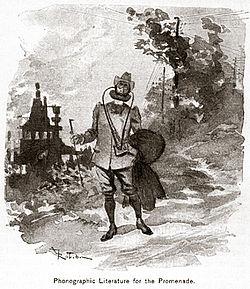Talk:Personal stereo
| This article is rated Start-class on Wikipedia's content assessment scale. It is of interest to the following WikiProjects: | |||||||||||
| |||||||||||
| The contents of the Astraltune page were merged into Personal stereo on 18 July 2020. For the contribution history and old versions of the redirected page, please see its history; for the discussion at that location, see its talk page. |
Possible illustration
[edit]
I think this would be a nice additional illustration, if someone could do a bit of research about the prehistory of personal stereo devices. --Hans Adler (talk) 10:51, 1 April 2009 (UTC)
Use/mention error
[edit]I have changed the first sentence. The rampant use/mention error is all over Wikipedia.
Maybe Doctor Emmet Brown's next task should be to write some 'script' or something, to get that fixed. --62.16.186.44 (talk) 00:58, 24 October 2015 (UTC)
Sony Walkman not being the first commercial personal stereo?
[edit]I was just leafing through some older newspapers when an ad for the National RQ-210S attracted my attention. It doesn't appear to be much larger than the iconic TPS-L2 by Sony but was offered at least in Australia in 1968. Sources: Advertisement in The Sydney Morning Herald (11/17/1968; p.41 (78)) | Radio Museum picture — 2A02:560:42EB:1300:995A:9FD:3F9A:B783 (talk) 16:28, 1 June 2020 (UTC)
- I can't see anything in the newspaper link but in the radiomuseum link I see a miniature dictation machine with a prominent record button. Not at all the same as a personal stereo device intended for portable playback. Binksternet (talk) 17:03, 1 June 2020 (UTC)
- That's similar to the Sony TC-50 which Apollo astronauts took around the moon with them in 1968. Here is a picture It was mono and its fundamental purpose was dictation but many crew members through the lunar shots took mixtapes with them and recorded over the songs as their mission progressed. [1] Sony made a range of these, as did other audio manufacturers, and some models in the 1970s made the leap from mono to stereo playback. But the first identifiable "personal stereo" marketed solely for the purpose of listening to music on the move was the Astraltune which released commercially in 1975. Here's a picture It was basically a repurposed car stereo held in a pouch and marketed to enthusiastic outdoor types. Its maker Roy Bowers failed to patent his idea. A similar fate befell Sony and other tech firms who considered the technology iterative not inventive. They all were beaten by Andreas Pavel who legally protected his Stereobelt two years later in 1977. Pavel is often credited with being the "inventor" of the personal stereo because he is said to have conceived his idea in 1972. However there is no hard evidence to support his timeline and inconsistencies in his story cast a shadow over his credibility. Pavel filed a writ against hardware makers in the 1980s and took Sony to court in London, asserting the hardware giant had "stolen" his idea. Sony was able to demonstrate in court that its engineers had begun working on a Walkman prototype shortly before Pavel's patent was granted to him, asserting nobody from the firm had ever met him, that nobody knew of his existence or idea. Sony's own engineers testified under oath that the Walkman was not even the first time they had toyed with the idea of designing a lighter, more practically porable stereo player for personal use; none of these earlier attempts came to fruition, not for lack of will, but because the means to produce high-quality sound with minimal operating power wasn't technically feasable at that time. The British courts ruled against Andreas Pavel, revoking his patent, finding upon inspection there was nothing significantly inventive about his design. The Stereobelt borrowed heavily and was basically a modular version of technology that already existed on the market. Moreover, slightly bulkier, portable stereo players with headphones and shoulder straps were already growing in popularity for personal use. Judges also noted irony in Pavel's prototype using Sony branded equipment. In any case, the ruling held that all such audio players were generic and failed patentability. Still many press articles ignore the Astraltune and deeper history of portable stereo players on the lone word of Andreas Pavel, who says his idea came to him in 1972 but he failed to act on it until half a decade later. And the press loves a David and Goliath story so why not. But for the purpose of fullness perhaps our article should record the existence of Astraltune. — Niche-gamer 23:02, 1 June 2020 (UTC)
Merger proposal
[edit]- The following discussion is closed. Please do not modify it. Subsequent comments should be made in a new section. A summary of the conclusions reached follows.
- The result of this discussion was merge . Alan Islas (talk) 12:55, 18 July 2020 (UTC)
I propose to merge Astraltune into Personal stereo. As explained by Niche-gamer, Astraltune is important in the history of the personal stereo and should be included in this article. However, I do not think it has enough notability to warrant its own article. The content of Astraltune can be integrated into this article without issues and will benefit from the expanded context. Alan Islas (talk) 13:26, 10 July 2020 (UTC)
- I have no objection. Astraltune Stereopack is important other than being the first commercial personal stereo player in that it further attempted to popularize the idea of high quality music on the move. It might be hard to convey the full story without reliable sources however. — Niche-gamer 13:53, 10 July 2020 (UTC)
- Thanks for your response. I'll start by merging the content that is there, hopefully it can get improved later, especially the sources as you say. --Alan Islas (talk) 12:55, 18 July 2020 (UTC)

